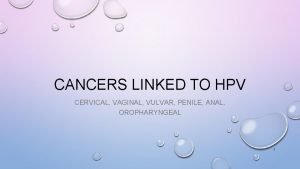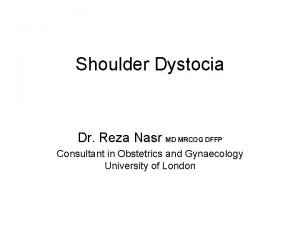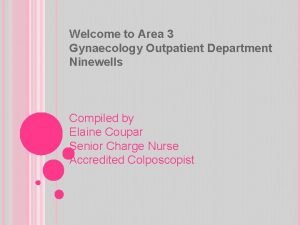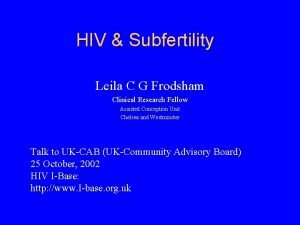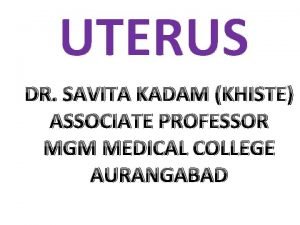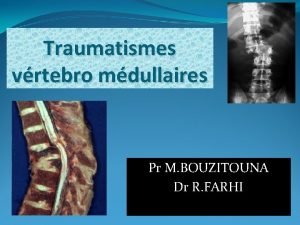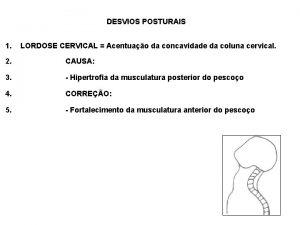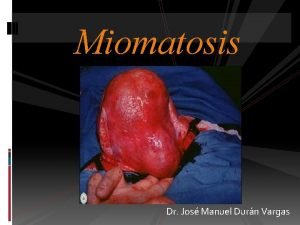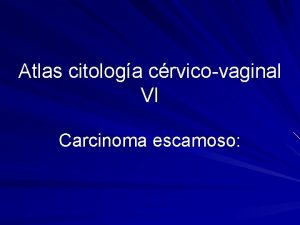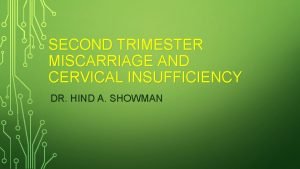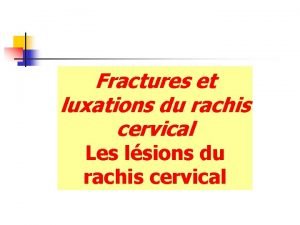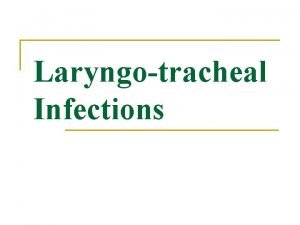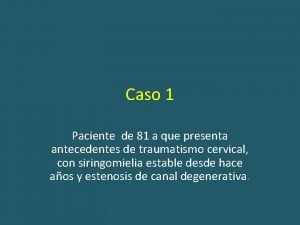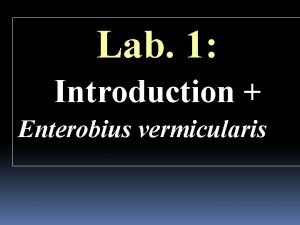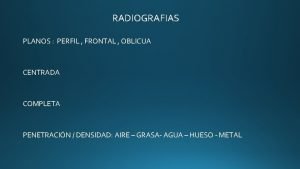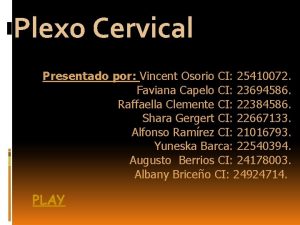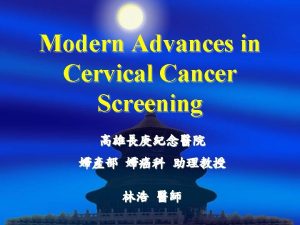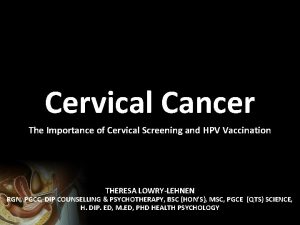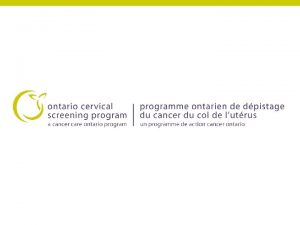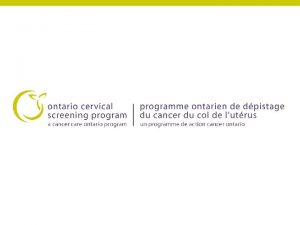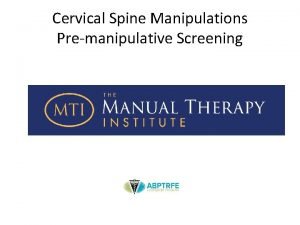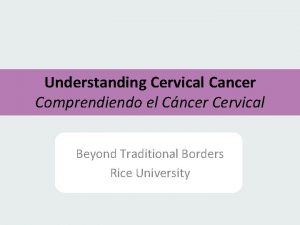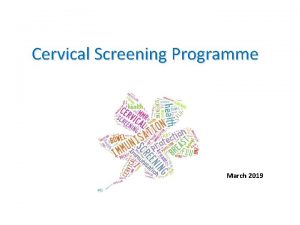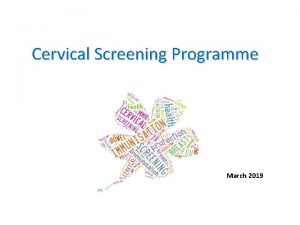Cervical cancer screening tests Dr Leila Sarikhani Gynecologist






























































- Slides: 62


Cervical cancer screening tests Dr. Leila Sarikhani (Gynecologist) Gerash Medical University












INTRODUCTION �Cervical cancer screening detects preinvasive neoplasia �maks treatment possible before the disease becomes invasive. �Screening is performed using cervical cytology (Pap test), or a human papillomavirus (HPV) test, or a combination of the two tests.

�Papanicolaou (Pap) smear screening test for cervical cancer introduced in the United States in 1941 �The Pap smear has become a model for cancer screening

Specimens for cytology � There are two methods for preparing a specimen for cervical cytology: conventional Pap smear liquid-based( Thin. Prep).

�cells are obtained from : ectocervix endocervix transformation zone (squamocolumnar junction)

Collection device � spatula �endocervical brush �single broom device � Cotton tipped swabs collect fewer endocervical cells to detect CIN so should be avoided

Sample collection �plastic spatula circumferentially scrape the ectocervix (for liquid-based samples) �wood or plastic is fine for conventional smears �Sampling ectocervix before endocervix will minimize bleeding �Rotate the brush 180º to obtain a sample.


conventional Pap smear �cells, sampled from cervix & vagina �using a brush or spatula �placed directly on slide �slide is rapidly fixed �If spray fixatives are used, should be held at least 10 inches away







liquid-based cytology ü Cells are sampled similarly ü suspended in a liquid transport ü Cells filtered &plated as thin layers on slides.


�In women at high risk for vaginal cancer additional samples from the anterior and posterior fornices should be obtained

In women with cervical stenosis �Perform Pap testing during menses. �Grasp the anterior lip whit tenaculum. �Apply gentle traction , stabilize the cervix &provide enough conter-tension to insert a sampling device into the external cervical os. �Administer a para- or intracervical block and use small mechanical dilators to dilate the cervix.

Liquid-based advantages over conventional �less fixation and drying artifact, and less cellular obscuration on the slide resulting in fewer unsatisfactory tests �The opportunity to re-test the liquid preparation at a later date for HPV

CHOOSING CONVENTIONAL SMEARS vs LIQUID-BASED CYTOLOGY �No general recommendation can be made ACOG advises that either method is acceptable �Liquid-based systems provide : greater specimen adequacy, particularly for women with cervical bleeding or inflammation no advantages vs conventional cytology for detection of HSIL (lesions most likely to progress to invasive disease)

�Better advantages to detecte ASCUS or LSIL �Perform better for detection of atypical glandular cells �The ability to obtain reflex HPV testing from a single liquid-based specimen �Costs vary by screening strategy and health care setting

Cytology report �A description of specimen type : conventional Pap smear liquid based cytology, or other �A description of specimen adequacy �A general categorization (optional) : negative epithelial cell abnormality, or other �An interpretation/result : negative for intraepithelial lesions & malignancy epithelial cell abnormality defined by the Bethesda 2001 classification

Interpretation/result Negative for intraepithelial lesion or malignancy (when there is absence of neoplasia this should be stated specifically, regardless of other findings) In addition describe, if present: Infection (Trichomonas vaginalis, Candida spp, shift in flora consistent with bacterial vaginosis, Actinomyces spp, cellular changes) Other nonneoplastic findings, such as, but not limited to: Reactive cellular changes associated with inflammation/cellular repair, radiation, or an intrauterine contraceptive device Glandular cells post hysterectomy Atrophy Other

Epithelial Cell Abnormalities Squamous Atypical squamous cells (ASC) of undetermined significance (ASC-US) cannot exclude HSIL (ASC-H) LSIL (encompassing HPV/mild dysplasia/CIN; CIN 1) HSIL (encompassing moderate and severe dysplasia, carcinoma in situ; CIN 2 and CIN 3) Squamous cell carcinoma

Glandular Atypical glandular cells (AGCs) (indicate endocervical, endometrial, or NOS) AGCs, favor neoplastic (indicate endocervical or not otherwise specified or specify in comments) Endocervical adenocarcinoma in situ (AIS) Adenocarcinoma Endometrial cells in a woman > 40 years of age

Abnormal cytology Normal cytology


Previous Systems and the Bethesda System Pap Classes Description Bethesda 2001 I Normal and variants II Reactive Changes Atypia ASC, ASG Koilocytosis Low Grade SIL III CIN I Mild dysplasia Low Grade SIL III CIN II Moderate dysplasia High Grade SIL III CIN III Severe dysplasia High Grade SIL IV Ca in situ, suspicious High Grade SIL V Invasive Microinvasion (<3 mm) Frankly invasive (>3 mm)

Sources of potential error in sampling �Not sample the area of cervical abnormality �The abnormal cells may not be plated on the slide or transferred to the liquid medium. �The cells may not be adequately preserved with fixative. �The cytopathologist may not identify the abnormal cells. �not accurate report

MISPERCEPTIONS ABOUT FACTORS THAT INTERFERE WITH SAMPLING 1. 2. 3. 4. Menses or other genital tract bleeding Interval between Pap tests Gel lubricants and other contaminants Vaginal intercourse, and tampon use

Menses or other genital tract bleeding Historically, women advised avoid testing during menses or other genital tract bleeding!? ! � We suggest : Performing rather than deferring Cleaning the cervix with cotton swab If there is obscuring blood liquid based methods is preferred �HPV testing results are not affected by bleeding.

Gel lubricants and other contaminants � lubricant gel, vaginal discharge, intravaginal medications: On a conventional smear make the smear thick & difficult to read. gently removed discharge with cotton swab �Gel lubricant on the speculum or on an examiner's hand not valid concern �two large studies (n=3460 and n=8534) Speculum lubricated gel or water prior for conventional Pap smear unsatisfactory smears were similar for both groups (gel: 1. 1 and 1. 4 percent; water: 1. 5 and 1. 3 percent) no differences in detection of of cervical abnormality

Interval between Pap tests � may repeat after a brief interval if: sample is unsatisfactory at the time of colposcopy � A short interval between Pap tests (15 - 30 d) does not appear to affect sensitivity for detection of cervical neoplasia

Vaginal intercourse, douching, and tampon use Women typically advised to refrain from vaginal activities (eg, douching, tampon use, sexual intercourse) during the 48 hours prior to a Pap test!? ! There are few data that directly assess the effect of vaginal activities on the ability of cervical cytology to detect cervical neoplasia. Further study is needed to evaluate the effect of vaginal intercourse & douching on cervical cytology or HPV testing.

Risk of cervical cancer with HPV �High-risk (oncogenic or cancer-associated) types Common types: 16, 18, 31, 33, 35, 39, 45, 51, 52, 56, 58, 59, 68, 69, 82 �Low-risk (non-oncogenic) types Common types: 6, 11, 40, 42, 43, 44, 54, 61, 72, 81

HPV testing � Specimens for HPV testing can be collected from the endocervix using a Dacron swab or cervical brush, which placed in HPV test transport medium �If liquid-based cytology sampling is performed, the same specimen can be used for HPV testing and cytology. �Commercial HPV assays only test for HPV types that have been associated with cancer. These HPV types are called oncogenic or high risk HPV

HPV Testing for Primary Cervical Cancer Screening �FDA approved( 2003 )Hybrid Capture 2 test for HR HPV in combination with cytology for cervical cancer screening in women ≥ 30 � The combination of HPV DNA testing with cytology increases the sensitivity of a single Pap test for highgrade neoplasia from 50 to 85 percent, to nearly 100 percent(American College of Obstetricians and Gynecologists, 2005 b) �Women ≤ 30 years, the high prevalence of HR HPV infection makes this strategy too nonspecific for use.

New screening algorithm Women aged 30 -64 y HPV test positive negative Normal 5 y recall Normal or borderline cytology ≥mild HPV & cytology 6 -12 m Cytology negative HPV negative Normal 5 y recall HPV positive &cytology<mild HPV negative & cytology borderline HPV & cytology 6 -12 m colposcopy Cytology≥ mild colposcopy

Cervical Cytology Screening Guidelines ACS Initiation of screening Screening intervals for women at average risk ACOG USPSTF See ACS Age 30: annual if conventional smear; every 2 years if LBC test Age 30: annual At least every 3 years Age >30: every 2 to 3 years after 3 consecutive negative tests Age >30: see ACS Approximately 3 years after onset of vaginal intercourse; no later than age 21

ACS Screening intervals for women at higher risk ACOG HIV + or other HIV +: see ACS immunocompromis Other ed state: 2 tests immunocompromis during first year ed states, DES: may after immune require more disease diagnosis, frequent screening then annually (per CDC) History of CIN 2 or 3 or cervical cancer: annual USPSTF No specific recommendations

Discontinuat ion of screening ACS ACOG USPSTF Age 70: consider if 3 documented negative (and no abnormal) tests in prior 10 years Age 70 in low-risk women Age 65 if not otherwise at high risk for cervical cancer Continue if screening history uncertain, history of cervical cancer, DES, recent HPV +, HIV + status, other immunocompromised state Continue if high risk, sexually active, history of multiple sexual partners, or history of abnormal cytology

Screening after hysterectom y ACS ACOG USPSTF Not indicated if removal confirmed for benign indication Subtotal hysterectomy: continue screening per guidelines Not indicated if removal confirmed with benign pathology and past negative cytologies Not recommended if total hysterectomy for benign disease Continue screening if history of DES or cervical cancer See ACS Positive or uncertain history of CIN 2 or 3: annual screening until 3 negative tests obtained, then may discontinue See ACS

OTHER SCREENING MODALITIES �Visual inspection (Unmagnified visualization of cervix) Visual inspection with acetic acid (VIA) or Lugol's iodine is used for cervical cancer screening in some developing countries �Aceto white changes after application may indicate : Abnormal transformation zone Areas of increased cellular density with increased abnormal nuclei and DNA content

VIA Advantages �Quick, easy, and non-invasive �Requires minimal equipment �Results are immediately available �Good sensitivity-especially for higher grade lesions �Few false negatives

VIA Disadvantages �Lower specificity (more false positives) �Increased costs for referrals to colposcopy �Potential of unnecessary biopsies �Follow up of abnormal that don’t get colposcopies




Thanks for your attention
 Dr sanaz sari khani
Dr sanaz sari khani National breast and cervical cancer early detection program
National breast and cervical cancer early detection program Hpv cervical cancer
Hpv cervical cancer National breast and cervical cancer early detection program
National breast and cervical cancer early detection program Cervical cancer hcp
Cervical cancer hcp Stage 4 cervical cancer
Stage 4 cervical cancer Hpv cervical cancer
Hpv cervical cancer Lung cancer screening shared decision making tool
Lung cancer screening shared decision making tool Ace different tests help iq but
Ace different tests help iq but Helper shoulder dystocia
Helper shoulder dystocia Gynaecology assessment unit ninewells
Gynaecology assessment unit ninewells Dr reza nasr gynecologist
Dr reza nasr gynecologist Dr guerra gynecologist
Dr guerra gynecologist Dr jameela gynecologist
Dr jameela gynecologist Piki kirjasto lainani
Piki kirjasto lainani Leila welch
Leila welch Leila rittey
Leila rittey Leila bouchkara
Leila bouchkara My living sacrifice
My living sacrifice Leila jalali
Leila jalali Leila k
Leila k Leila mureebe
Leila mureebe Leila risteli
Leila risteli Dr leila frodsham
Dr leila frodsham Leila nabulsi
Leila nabulsi Leila k
Leila k Leila ben ayed
Leila ben ayed Leila sarangi
Leila sarangi Leila g davis
Leila g davis Leila imię
Leila imię Webhassan
Webhassan Brasileirinhas pornográfico
Brasileirinhas pornográfico Old tongue by jackie kay
Old tongue by jackie kay Mackenrodts ligament
Mackenrodts ligament Entorse cervical
Entorse cervical Esophagus
Esophagus Lordose cervicale
Lordose cervicale Metrorragia
Metrorragia Mzunguko wa hedhi
Mzunguko wa hedhi Uterine irritability
Uterine irritability Atlas de citologia cervical
Atlas de citologia cervical Dermatoma cervical
Dermatoma cervical Recto anterior menor de la cabeza
Recto anterior menor de la cabeza Discartrosis degenerativa
Discartrosis degenerativa Cervical circulage
Cervical circulage Diarrhea reflexology
Diarrhea reflexology Entorse cervical
Entorse cervical Cervical nodes
Cervical nodes Endocervical polyp
Endocervical polyp Cervical sinus
Cervical sinus Cervical
Cervical Accion articular desaconsejada
Accion articular desaconsejada Sirinx cervical
Sirinx cervical Plexo cervical
Plexo cervical Intumescencia cervical
Intumescencia cervical Cellulose tape swab
Cellulose tape swab Restricted cervical injection embalming
Restricted cervical injection embalming Renforcement rachis cervical
Renforcement rachis cervical Radiografia de cadera normal
Radiografia de cadera normal Maxillary central incisor aspects
Maxillary central incisor aspects Plexo cervical profundo
Plexo cervical profundo Cervical peripheral nerves
Cervical peripheral nerves Referred pain chart
Referred pain chart






